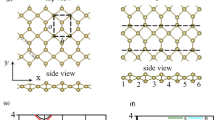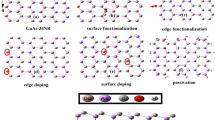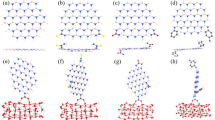Abstract
We propose a quasi-one-dimensional P-substituted tellurene nanoribbon (TeNR) (with sizes ranging from 7 to 5 Å) based on a β-Te monolayer configuration using the first principles of density functional theory (DFT) calculations. This system appears to have outstanding electronic and optical properties as revealed by its energy band structure, density of state (DOS), and optical spectrum. P-substituted TeNR has lower formation energy than that of pristine TeNR, indicating that it is more stable than the pristine TeNR. In the presence or absence of the spin–orbit coupling (SOC), P-substituted TeNRs were semiconductors and their direct bandgaps decrease with increasing bandwidth. The DOS and projected DOS are mainly derived from the contributions of the p orbital electrons of Te and P atoms. The dielectric functions of P-substituted TeNRs exhibited optical anisotropy. The absorption spectrum is selective for the incident light energy, and an absorption peaks in the visible and ultraviolet regions indicate that P-substituted n-TeNRs could not only harvest considerable visible light but also capture ultraviolet light, and the peaks also have a trend of red-shift. These findings on quasi-one-dimensional Te nanostructures effectively extend the realm of group VI elements.









Similar content being viewed by others
Data availability
All the data and materials applied in the study will be made available from the corresponding author only on academic or other non-business requests.
References
Novoselov KS, Geim AK, Morozov SV, Jiang D, Zhang Y, Dubonos SV, Grigorieva IV, Firsov AA (2004) Electric field effect in atomically thin carbon films. Sci 306:666–669. https://doi.org/10.1126/science.1102896
Yang YE, Yang YR, Yan XH (2012) Universal optical properties of graphane nanoribbons a first-principles study. Physica E 44:1406–1409. https://doi.org/10.1016/j.physe.2012.03.002
Xu WW, Xu WP, Zhan FY, Laref A, Wang R, Wu XZ (2019) Effects of Stone-Wales defect on the electronic and optical properties of armchair MoS2 nanoribbon: First-principles calculations. J Electron Mater 48:3763–3776. https://doi.org/10.1007/s11664-019-07141-6
Pang Q, Li L, Zhang CL, Wei XM, Song YL (2015) Structural, electronic and magnetic properties of 3d transition metal atom adsorbed germanene: a first-principles study. Mater Chem Phys 160:96–104. https://doi.org/10.1016/j.matchemphys.2015.04.011
Shi Z, Cao R, Khan K, Tareen AK, Liu XS, Liang WY, ZhangY MCY, Guo ZN, Luo XL, Zhang H (2020) Two-dimensional tellurium: progress, challenges, and prospects. Nano-Micro Lett 12:99–132. https://doi.org/10.1007/s40820-020-00427-z
Qiao J, Pan Y, Yang F, Wang C, Chai Y, Ji W (2018) Few-layer tellurium: one-dimensional-like layered elementary semiconductor with striking physical properties. Sci Bull 63:159–168. https://doi.org/10.1016/j.scib.2018.01.010
Liang ZF, Wang Y, Hua CQ, Xiao CC, Chen MG, Jiang Z, Tai RZ, Lu YH, Song F (2019) Electronic structures of ultra-thin tellurium nanoribbon. Nanoscale 11:14134–14140. https://doi.org/10.1039/C9NR04112E
Apte A, Bianco E, Krishnamoorthy A, Yazdi S, Rao R, Glavin N, Kumazoe H, Varshney V, Roy A, Shimojo F, Ringe E, Kalia RK, Nakano A, Tiwary CS, Vashishta P, Kochat V, Ajayan PM (2018) Polytypism in ultra-thin tellurium. 2D Mater 6:015013(1–9). https://doi.org/10.1088/2053-1583/aae7f6
Wang Q, Safdar M, Xu K, Mirza M, Wang Z, He J (2014) Van der Waals Epitaxy and Photoresponse of Hexagonal Tellurium nanoplates on flexible mica sheets. ACS Nano 8:7497–7505. https://doi.org/10.1021/nn5028104
Xie Z, Xing C, Huang W, Fan T, Zhao ZLJ, Xiang Y, Guo Z, Li L, Yang Z, Dong B, Qu J, Fan D, Zhang H (2018) Ultrathin 2D nonlayered tellurium nanosheets: facile liquid-phase exfoliation, characterization, and photoresponse with high performance and enhanced stability. Adv Funct Mater 28:1705833(1–11). https://doi.org/10.1002/adfm.201705833
Zhu Z, Cai X, Yi S, Chen J, Dai Y, Niu C, Guo Z, Xie M, Liu F, Cho JH, Jia Y, Zhang ZY (2017) Multivalency-driven formation of Te-based monolayer materials a combined first principles and experimental study. Phys Rev Lett 119:106101–7. https://doi.org/10.1103/physrevlett.119.106101
Ouyang YJ, Sanvito S, Guo J (2010) Effects of edge chemistry doping on graphene nanoribbon mobility. Surf Sci 605:217–218. https://doi.org/10.1109/drc.2010.5551920
Zhong BN, Fei GT, Fu WB, Gong XX, Gao XD, Zhang L (2016) Solvothermal synthesis, stirring-assisted assembly and photoelectric performance of Te nanowires. Phys Chem Chem Phys 18:32691–32691. https://doi.org/10.1039/c6cp04979f
Pang Q, Zhang Y, Zhang JM, Ji V, Xu KW (2011) Electronic and magnetic properties of pristine and chemically functionalized germanene nanoribbons. Nanoscale 3:4330–4338. https://doi.org/10.1039/c6cp04979f
Zhong BN, Fei GT, Fu WB, Gong XX, Xu SH, Gao XD, Zhang DL (2017) Controlled solvothermal synthesis of single-crystal tellurium nanowires, nanotubes and trifold structures and their photoelectrical properties. CrystEngComm 19:2813–2820. https://doi.org/10.1039/c7ce00497d
Lin CS, Cheng WD, Chai GL, Zhang H (2018) Thermoelectric properties of two-dimensional selenene and tellurene from group-VI elements. Phys Chem Chem Phys 20:24250–24256. https://doi.org/10.1039/c8cp04069a
Zhang W, Wu QS, Yazyev OV, Weng HM, Guo ZX, Cheng WD, Cai GL (2018) Topological phase transitions driven by strain in monolayer tellurium. Phys Rev B 98:115411(1–8). https://doi.org/10.1103/physrevb.98.115411
Amani M, Tan CL, Zhang G, Zhao CS, Bullock J, Song XH, Hyungjin K, Shrestha VR, Gao Y, Crozier KB, Scott M, Javey A (2018) Solution-synthesized high-mobility tellurium nanoflakes for short-wave infrared photodetectors. ACS Nano 12:7253–7263. https://doi.org/10.1021/acsnano.8b03424
Wang Y, Xiao CC, Chen MG, Hua CQ, Zou JD, Wu C, Jiang JZ, Yang SYA, Lu YH, Ji W (2018) Two-dimensional ferroelectricity and switchable spin-textures in ultra-thin elemental Te multilayers. Mater Mater Horiz 5:521–528. https://doi.org/10.1039/c8mh00082d
Wang JJ, Shen H, Yu ZY, Wang SY, ChenYY WuBR, Su WS (2020) Electric field-tunable structural phase transitions in monolayer tellurium. ACS Omega 5:18213–18217. https://doi.org/10.1021/acsomega.0c01833
Dong YJ, Wang XF, Vasilopoulos P, Zhang MX, Wu XM (2014) Half-metallicity in aluminum-doped zigzag silicene nanoribbons. J Phys D Appl Phys 47:105304(1–6). https://doi.org/10.1088/0022-3727/47/10/105304
Kresse G (1995) Ab initio molecular dynamics for liquid metals. J Non Cryst Solids 192–193:222–229. https://doi.org/10.1016/0022-3093(95)00355-x
Kresse G, Hafner J (1994) Ab initio molecular-dynamics simulation of the liquid-metal-amorphous-semiconductor-tor transition in germanium. Phys Rev B 49:14251–14269. https://doi.org/10.1103/physrevb.49.14251
Kresse G, Furthmüller J (1996) Efficiency of ab-initio total energy calculations for metals and semiconductors using a plane-wave basis set. Comput Mater Sci 6:15–50. https://doi.org/10.1016/0927-0256(96)00008-0
Kresse G, Furthmüller J (1996) Efficient iterative schemes for ab initio total-energy calculations using a plane-wave basis set. Phys Rev B 54:11169–11186. https://doi.org/10.1103/physrevb.54.11169
Kresse G, Joubert D (1999) From ultrasoft pseudopotentials to the projector augmented wave method. Phys Rev B 59:1758–1775. https://doi.org/10.1103/physrevb.59.1758
Perdew JP, Burke K, Ernzerhof M (1996) Generalized gradient approximation made simple. Phys Rev Lett 77:3865–3868. https://doi.org/10.1103/PhysRevLett.77.3865
Wu BZ, Liu XH, Yin JR, Hyoyoung L (2017) Bulk β-Te to few layered β-tellurenes: indirect to direct band-gap transitions showing semiconducting property. Mater Res Express 4:095902-(1-9). https://doi.org/10.1088/2053-1591/aa8ae3
Lu DB, Song YL (2018) First principles calculations of optical properties of the armchair SiC nanoribbons with O F and H termination Pramana. J Phys 90:37-(8). https://doi.org/10.1007/s12043-017-1519-4
Lu DB, Song YL, Huang XY (2019) Electric and optical properties modulations of armchair silicene nanoribbons by transverse electric fields. Curr Appl Phys 19:31–36. https://doi.org/10.1016/j.cap.2018.11.001
Wei W, Yang S, Wang G, Zhang T, Pan W, Cai Z, Yang Y, Zheng L, He P, Wang L, Baktash A, Zhang LL, Wang Y, Ding G, Kang Z, Yakobson BI, Searles DJ, Yuan Q (2021) Bandgap engineering of two-dimensional C3N bilayers. Nat Electron 4:486–494. https://doi.org/10.1038/s41928-021-00602-z
Khan MJI, Kanwal Z, Latif A, Ahmad J, Akhtar P, Yousaf M, Ullah H (2021) Investigations on electronic structure, magnetic and optical properties of C and Ti co-doped zincblende GaN for optoelectronic applications. Optik 231:166425-(12). https://doi.org/10.1016/j.ijleo.2021.166425
Chen ZY, Zhao SQ, Zhao HH, Zou YB, Yu CY, Zhong WB (2021) Tetrabutylphosphonium acetate and its eutectic mixtures with common-cation halides as solvents for carbon dioxide capture. Chem Eng J 409:127891(1–9). https://doi.org/10.1016/j.cej.2020.128191
Agrawal S, Srivastava A, Kaushal A (2022) Bandgap engineering in Ga and P doped armchair graphene nanoribbons: DFT analysis. Mater Today: Proc 48:647–649. https://doi.org/10.1016/j.matpr.2021.05.706
Guo G, Shi YM, Zhang Y, Deng YX, Du FM, Xie ZX, Tang J, Mao YL (2020) First-principles study on the electronic and magnetic properties of P edge-doped armchair germanium selenide nanoribbon. Comp Mater Sci 172:109348–109354. https://doi.org/10.1016/j.commatsci.2019.109348
Zhang JM, Song WT, Xu KW, Ji V (2014) The study of the P doped silicene nanoribbons with first-principles. Comp Mater Sci 95:429–434. https://doi.org/10.1016/j.commatsci.2014.08.019
Saha S, Sinha TP, Mookerjee A (2000) Electronic structure, chemical bonding, and optical properties of paraelectric BaTiO3. Phys Rev B 62:8828–8834. https://doi.org/10.1103/physrevb.62.8828
Santhibhushan B, Soni M, Srivastava A (2017) Optical properties of boron-group (V) hexagonal nanowires: DFT investigation. Pramana-J Phys 89:14. https://doi.org/10.1007/s12043-017-1406-z
Fang CY, Wang X, Zhang Q, Zhou JY (2022) First-principles calculations on semiconducting ε-GeS and ε-SnS monolayer nanosheets with photocatalytic activity for sunlight driven water splitting. ACS Appl Nano Mater 5:3900–3912. https://doi.org/10.1021/acsanm.1c04495
Zhang Q, Wang X, Yang SL (2021) δ-SnS: an emerging bidirectional auxetic direct semiconductor with desirable carrier mobility and high-performance catalytic behavior toward the water-splitting reaction. ACS Appl Mater Interfaces 13:31934–31946. https://doi.org/10.1021/acsami.1c03650
Acknowledgements
The authors would like to acknowledge support from the Teaching Reform of the Steering Committee of Electronic Information Specialty of the Chinese Ministry of Education (Grant No. 2020-YB-23) and Teaching Research of Higher Education in Henan Province (Grant No. 2019SJGLX379, 2021SJGLX484).
Author information
Authors and Affiliations
Contributions
Yuling Song: collected references, calculated and analyzed data, conceived and designed paper layouts, and drafted manuscripts. Daobang Lu: supervised the work and presided over the analysis and revision of the manuscript. Xiaoyu Huang: presided over the analysis and revised the manuscript.
Corresponding author
Ethics declarations
Conflict of interests
The authors declare no competing interests.
Ethics approval
This article does not contain any studies involving human participants or animals performed by any authors.
Additional information
Publisher's note
Springer Nature remains neutral with regard to jurisdictional claims in published maps and institutional affiliations.
Rights and permissions
Springer Nature or its licensor (e.g. a society or other partner) holds exclusive rights to this article under a publishing agreement with the author(s) or other rightsholder(s); author self-archiving of the accepted manuscript version of this article is solely governed by the terms of such publishing agreement and applicable law.
About this article
Cite this article
Song, Y., Lu, D. & Huang, X. Electronic and optical properties of P-substituted tellurene nanoribbons: first principles study. J Nanopart Res 24, 231 (2022). https://doi.org/10.1007/s11051-022-05614-0
Received:
Accepted:
Published:
DOI: https://doi.org/10.1007/s11051-022-05614-0




